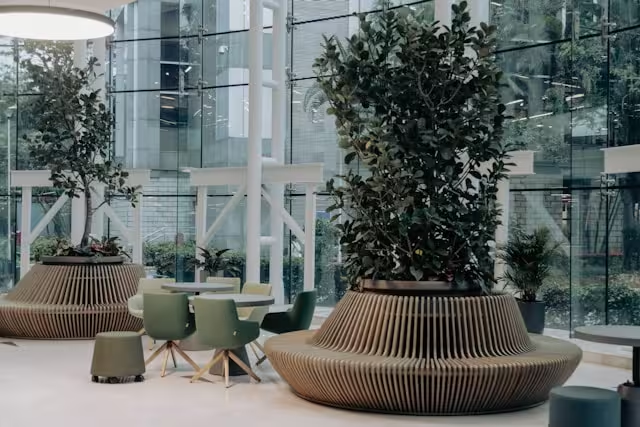A sober analysis of contemporary human behavior reveals a marked shift in our environmental interactions. The average person as of 2025 now dedicates upwards of seven hours daily to digital interfaces, a migration that has inadvertently created a significant ‘nature deficit.’ This experiential void correlates directly with increased cognitive fatigue, heightened stress levels, and a demonstrable decline in user engagement within these very environments.
In response, a compelling framework is gaining critical traction, not as a fleeting aesthetic trend, but as an evidence-based methodology for creating more effective and restorative digital platforms. Biophilic design offers a systematic approach to re-introducing elements of the natural world into our digital habitats, with the express purpose of building more human-centric experiences. This analysis will serve as a comprehensive primer, beginning with a foundational definition of the biophilia hypothesis itself, then deconstructing its core principles for digital application, and concluding with actionable strategies for implementation.
Table of Contents
What is Biophilia? From Hypothesis to Foundational Design Principle

To understand its application, one must first grasp its origin. The core concept is the biophilia hypothesis, a term formally introduced and popularized by the biologist Edward O. Wilson. He posited that humans possess an inherent, genetically rooted inclination to affiliate with the natural world. This is not a preference learned in a single lifetime but an evolutionary inheritance from millennia spent in close communion with natural systems.
This hypothesis is not merely philosophical; it is substantiated by a growing body of empirical evidence from disciplines like environmental psychology and neuroscience. Controlled studies consistently demonstrate that exposure to natural elements or even analogues of nature can elicit measurable physiological responses: a reduction in cortisol (the primary stress hormone), a lower resting heart rate, and an improvement in cognitive functions like directed attention and memory recall.
Initially, these principles were translated into the physical world through biophilic architecture. Architects and interior designers began to systematically incorporate daylight, vegetation, natural materials, and views of nature into the built environment, creating spaces that demonstrably improved the health, well-being, and productivity of occupants. As of 2025, this proven framework is now being rigorously adapted for the digital frontier. The same principles used to mitigate the stress of a sterile office are being deployed to address the cognitive fatigue induced by a sterile digital interface.
The Core Patterns of Biophilic Digital Design
The application of biophilia in digital design is not an arbitrary placement of natural imagery. It is a structured methodology based on established patterns, most notably those defined by Stephen R. Kellert. These can be grouped into three primary categories of experience.

1. Nature in the Space (Direct Experience)
This pattern involves the direct and unambiguous inclusion of nature within the digital interface. The goal is to create a tangible, albeit virtual, connection to living systems.
- Visual Connection with Nature: The most direct application is the use of high-quality, authentic photography and videography of natural subjects. This goes beyond generic stock photos to include dynamic landscape backgrounds, subtle video textures of moving water or windblown leaves, and clear imagery of flora.
- Natural Color Palettes: This involves creating UI color schemes derived from natural environments. Think of the deep greens and rich browns of a forest floor, the layered blues and sandy tans of a coastline, or the vibrant hues of a wildflower meadow. These palettes are inherently harmonious and less straining on the eye than purely artificial color combinations.
- Dynamic & Diffuse Light: Natural light is rarely static or harsh. This principle is applied by simulating its properties in digital design. This can be achieved through soft gradients that mimic a sunrise, subtle shadows that create depth and realism, or background textures that suggest dappled light filtering through a canopy.

2. Natural Analogues (Indirect Experience)
This category involves the use of objects, materials, and patterns that evoke nature through mimicry and abstraction rather than literal representation.
- Biomorphic Forms & Patterns: Human-made environments are dominated by straight lines and right angles. Nature, by contrast, is composed of organic curves, complex lines, and repeating patterns. Integrating biomorphic forms—such as UI elements with rounded corners, layouts that flow organically, or decorative motifs based on botanical or animal forms—can make an interface feel more natural and less rigid. This includes the use of fractals—the complex, self-repeating patterns found in everything from ferns to snowflakes—which our brains process with remarkable ease and satisfaction.
- Material Connection with Nature: While a screen is made of glass, its interface can simulate the textures of natural materials. Using subtle wood grain textures for buttons, a stone-like texture for a background panel, or a fabric weave like linen for a content card provides a visual and tactile suggestion that connects the user to familiar, natural materials.
3. Nature of the Space (Spatial Experience)
This is the most sophisticated application of biophilia, focusing on creating spatial configurations that resonate with innate human desires for comfort, safety, and a sense of control.
- Prospect & Refuge: This is a core evolutionary preference. ‘Prospect’ refers to an unimpeded view over a landscape, while ‘Refuge’ refers to a place of safety and protection. In web design, this translates to layouts that offer a clear, open main content area (the prospect) combined with well-defined, stable elements like a header, footer, or sidebar where the user feels grounded (the refuge). It gives the user a sense of command over the information architecture.
- Complexity & Order: Natural environments are a masterful blend of rich detail and overarching structure. A successful biophilic interface mirrors this. ‘Complexity’ is achieved through layers of information, rich textures, and interactive elements that invite exploration. ‘Order’ is maintained through a strong, logical grid system, clear navigation, and consistent visual hierarchy. This combination creates an experience that is engaging and interesting without ever becoming chaotic or confusing.
Commonly Asked Questions
What is an example of biophilic design on a website?
A clear example is the website for a wellness retreat. It might use a full-screen video background of a serene forest scene (Nature in the Space), a color palette of soft greens and earthy browns (Natural Analogues), and a layout with a large, clear central booking area flanked by reassuring testimonials in a defined sidebar (Prospect & Refuge). The buttons might have a subtle, smooth stone texture, and the font would be clean and highly legible against the natural backdrop.
Why is biophilic design important for UX?
Its importance for User Experience (UX) is rooted in its ability to reduce cognitive load. By creating an environment that feels intuitive and stress-free, it allows users to focus their mental resources on the task at hand, whether it’s absorbing information or completing a purchase. It improves user mood, which leads to higher perceived usability and satisfaction. This translates directly to core UX metrics like increased session duration, more pages per session, and lower bounce rates.
How does biophilia affect human behavior?
Biophilia affects behavior by first altering a user’s physiological and psychological state. By reducing stress and enhancing focus, it fosters a mindset conducive to positive engagement. Users in a relaxed state are more open to new information, exhibit higher levels of creativity, and feel a greater sense of trust toward the brand. This positive affective state directly influences decision-making, making users more likely to explore, convert, and form a positive long-term association with the digital entity.
Is biophilic design just about adding plants?
This is a fundamental misunderstanding. While incorporating botanical imagery is a component of the ‘Nature in the Space’ pattern, it is merely one tactic within a much broader strategic framework. True biophilic design is a holistic approach that considers space, light, color, texture, and pattern, as demonstrated by the 14 Patterns of Biophilic Design. Relying solely on plant photos without considering the underlying principles of order, prospect, or natural analogues fails to achieve the full, restorative effect.
The Tangible ROI of Biophilic Digital Design
While the principles are rooted in human well-being, the outcomes are directly tied to business objectives.
- Increased User Engagement: As established, a biophilic interface is inherently more engaging. It holds attention longer and reduces the mental friction that causes users to abandon a site. This directly impacts SEO and site authority through improved behavioral metrics.
- Improved Conversion Rates: A user who feels calm, focused, and trusts the brand is a user who is more likely to convert. The positive emotional state fostered by biophilic design reduces hesitation at key decision points, leading to a measurable uplift in sales, sign-ups, and other key performance indicators.
- Enhanced Brand Differentiation: In a digital landscape saturated with homogenous, sterile corporate designs, a biophilic approach is a powerful differentiator. It communicates a brand ethos of thoughtfulness, sustainability, and human-centricity. This creates a memorable identity that resonates with modern consumers who increasingly value authenticity and well-being.
Conclusion: Designing for Humans in a Digital World
Understanding biophilia in digital design is to understand that we are not designing for machines, but for a biological organism with innate needs and preferences. It is the evolution of design thinking from being merely functional to being fundamentally human. By systematically weaving the patterns of nature into the fabric of our digital platforms, we move beyond creating simple interfaces and begin engineering superior experiences.
As we push further into immersive technologies like AR and VR, the principles of biophilia will become even more critical in grounding those virtual worlds in a way that supports, rather than detracts from, human well-being. The ultimate goal is to create a digital ecosystem that is not a source of stress, but a space for restoration.